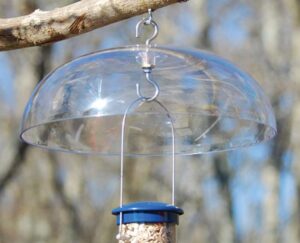
Just because the weather during wintertime becomes less inviting and more biting, it’s not a foregone conclusion that all hummingbirds have left for warmer climates. Depending on where you live, hummingbirds might actually stick around for longer than you think. For example, the Anna’s Hummingbird is no stranger to spending snowy winter days in Washington state while you might find other species in the icy Northeastern wintertime.
When temperatures dip below freezing, it’s even more difficult for hummingbirds to survive and thrive because their natural source of food is harder to find, which is why some Audubon groups and nature shops encourage you to feed hummers in the winter. (And let’s face, hummingbirds have it rough already.)
However, when you leave out hummingbird feeders in the cold, the nectar inside becomes susceptible to freezing, which can not only prevent hummingbirds from feeding but also cause cracks. So we’ve assembled these tips for keeping your hummingbird feeders from freezing over in the cold.
Place feeders in the sun and away from the wind
Feeders that are under awnings or covered patios will freeze quicker and stay frozen longer because they are not exposed to the sun. Wind is another contributor to frozen nectar. Harsh winds can keep nectar frozen longer, so find a spot sheltered from the wind.
Wrap the feeders in Christmas lights
Depending on how cold it is outside, the feeder might just need some light heat to keep the nectar from freezing. That’s where Christmas lights come in handy. The lights produce just enough heat to keep the nectar liquified. Alternatively, you could point a mechanics light at the feeder. Wild Bird Scoop has some pretty cool suggestions for keeping nectar unfrozen with lights.
Rotate between two feeders
This solution requires more work and vigilance, but it’s an easy solution. If you have two hummingbird feeders or want to buy another hummingbird feeder, you can simply swap out a fresh one from the house for the other when the nectar freezes. The good part is that you only have to do it during the day.
Take down feeders at night
Additionally, since hummingbirds don’t feed at night (and that’s when the temperatures are typically the lowest), bringing the feeders inside will also work.
Add some makeshift insulation
Any insulating material will help reduce the risk of freezing. Even wrapping the feeder in a layer or two of bubble wrap will work. You can get creative in this area and use whatever material you have available.
Use a weather baffle
 Having snow gather on top of a feeder will not only increase the likelihood that the nectar will freeze but it can also clog the ports. An easy solution is to put a baffle over the top. They make some specifically for weather (such as rain and snow), but a typical baffle will also make do.
Having snow gather on top of a feeder will not only increase the likelihood that the nectar will freeze but it can also clog the ports. An easy solution is to put a baffle over the top. They make some specifically for weather (such as rain and snow), but a typical baffle will also make do.
Avoid messing with the nectar recipe
The typical nectar recipe, which is one part sugar and four parts water, begins to freeze around 26 or 27 degrees. Some sites recommend making it sweeter to reduce the freezing point of nectar, but changing up the recipe can have health implications for hummingbirds. Implementing some of the above suggestions will usually be enough to keep nectar from freezing, so there’s no need to add more sugar.



4 Comments
1:3 instead of 1:4 but no higher.
how much sugar does he add to the water ?
My neighbor has added more sugar to his feeders in the winter for years, not only has it not frozen but he has acquired more hummingbirds during winter months